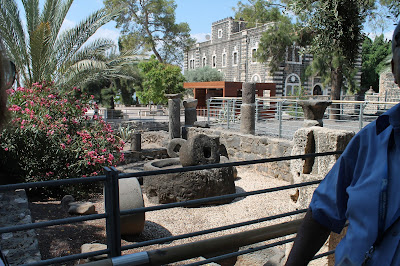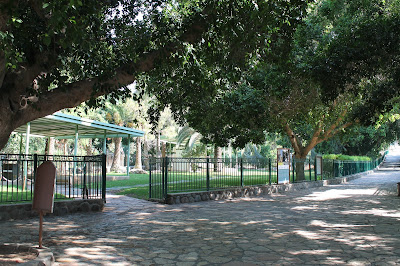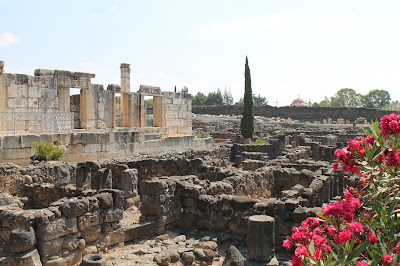We went with our pastor and our total group size was 16 people. We had a local bus driver and a local tour guide named Avi. Avi has worked with our pastor on most of the tours he has taken groups on and they are personal friends which made our trip that much better! Avi is a Jew who is not a christian, but his knowledge of not only the old testament, but the new testament definitely put me to shame and has challenged me to memorize more scripture. He has the head knowledge of the gospel and Jesus, but has not yet accepted Jesus as the true messiah. Hopefully he will one day!
Our main schedule every day was to wake up between 615 and 630am, eat breakfast at the hotel, then head out for the day to see as much as possible. We would eat lunch various places that were around where we were touring, and then would be back at the hotel between 5 and 6pm to have a bit of time to freshen up for dinner at the hotel. After dinner we had free time to visit and we usually went to bed early to be ready for the next day!
June 1-2 (traveling to Israel)
We left Austin June 1st about 4pm (after a 3 hour delay), and arrived at JFK for a layover at 830pm (eastern). We finally boarded the next flight after going through Israel's version of TSA at the gate and left about 1am. This flight was 9ish hours and we arrived in Tel-Aviv around 530pm on June 2nd. We had to go through customs at the airport and the bus picked us up and drove us an hour away to Netanya where our first hotel was. We had a late dinner and then went to bed!
June 3rd (first day of site-seeing)
Finally started to see the sites! Our first stop was Caesarea (by the sea). This city was right on the coast of the Mediterranean Sea, and this was where in Acts 26 Paul made his speech to Agrippa. The theater where he made his speech is still there!
 |
| Michael standing on the wooden platform where Paul probably made his speech |
We also saw the remains of Herod's palace and the "Pontias Pilate Stone" which is the first archaeological evidence found that he was a real person and the governor of Judea.
After leaving Cesarea, we drove by the huge aquaduct built by Herod that was used to bring water to the city.
Next stop was Mount Carmel. This is where Elijah and the prophets of baal had an encounter (1 Kings 18). There is a Monastery built up at the top. We sat in a shaded area and read aloud the story and Kie talked about how Elijah was a man of prayer and how prayer is accessible to every believer. He said we should keep praying and looking for a sign of God's promise no matter how small and cling to even the smallest evidence of His promise.
Behind the Monastery, there was a beautiful view of the valley below which is the Valley of Jezreel which is where the battle of Armageddon will be fought (Revelation 16:12 and 18:19). This valley is surrounded by moutains all around and the Kishon brook is at the bottom of Mt Carmel where Elijah killed all the prophets of baal.
The "V" you see in the middle picture is actually a landing strip for the Israeli army and they have a huge hidden underground storage area for all their planes.
 |
| 3000 yr old horse troughs |
 |
| remains of a stable |
 |
| underground tunnel that hid the water supply underneath the city |
Nazareth was our next stop!
We went to a synagogue that is not the original one from Jesus' time, but is built on the spot of the one that Jesus went to growing up. Today the town is pretty large and modern, but back when Jesus lived there, it was very small (approx 100 people). This is where Jesus came and read the scriptures and declared who he was (Luke 4:16-30).
After Nazareth, we made our way to our hotel for the next 2 nights in Tiberias. Our hotel was overlooking the water which was beautiful! Both these pictures were taken from the balcony off our room.
June 4th
This morning started out with a boat ride across the Sea of Galilee. I think the word "sea" is actually misleading since the entire area is only 14 miles long and 8 miles wide. It really looks more like a huge lake.
 |
| view of Tiberias from the boat |
Next stop was at the Mount of the Beatitudes where Jesus gave the sermon from Matthew 5:1-13. There is a Monastery run by nuns and the grounds are beautiful. We were able to see the possible area where Jesus would have stood as he spoke to the crowds as the mountain slopes down to a point making the acoustics great.
Chorazin (or Korazim) was the next stop. This area is now a national park, but used to be a prosperous town. In Matthew 11:20, this is one of the three towns that Jesus cursed, and once destroyed, was never rebuilt. The walls of the synagogue are original from the time of Jesus and they know this because of the way that they were built with large stones surrounded by small stones.
 |
| entrance of the synagogue |
 |
| Michael sitting in the "Moses Seat" which was a chair in the back reserved for important people |
After leaving Chorazin, we had a longer drive up to the northern area of Israel and went to Banias which in Biblical times was called Cesarea Philippi. This is the town where Jesus asked his disciples "who do you think I am?" and Peter responded "you are the Messiah" (Matthew 16:13-20). This town was small and in a remote area and Jesus would use this place as a prayer retreat. Historically, this town had a cave known as the Pan Cave where people would sacrifice children and worship the god Pan.
 |
| Just over on the other side is Syria, we were approx 600 yards away |
 |
| This stream is the headwaters for the Jordan River that flows down into the Sea of Galilee. Water comes here from melted snow off Mt Hermon |
And stopped for lunch where we had some fish caught in the Sea of Galilee. The fish wasn't too bad, but it was hard to eat it while it was looking at us!
June 5th (last day in the Galilee area)
Tabgha was the first stop of the day which is where Jesus fed the 5000. This area has always been green and lush from the springs that are located here. The feeding of the 5000 is the only miracle to occur in all 4 gospels. We stopped here a little longer and Kie spoke about this miracle and its significance to the New Testament writers.
 |
| one of the springs |
The culture dictated that on the Sabbath, you could not travel more than 1 mile, so everyone had houses right next to the synagogue. Men would spend 1 hour every morning and 15 min every evening at the synagogue as part of their daily ritual.
Mark 1:35-37 talks about Jesus' prayer ministry being here in a "solitary place" maybe up on the hill outside the city.
 |
| site they think was Peter's house, catholics built a church above it |
 |
| foundation of the synagogue was original from Jesus' time |
 |
| community olive press; a bull was attached to pull the stone and crush the olives |
Our next stop was Beth Se'an. This was one of the decapolis cities in the New Testament, and the Gilboa mountains where Saul was defeated and lost 3 of his sons are near here (1 Samuel 31). A huge theater was found here with 3 levels and held around 7000 people. The theater had "box seats" where there were sofas and food. They also uncovered a public toilet where both men and women relieved themselves in the same area. They would cover themselves with a long gown and use water to clean themselves.
 |
| one of the box seats in the theater |
 |
| inside the bathroom |
 |
| Michael demonstrating how the bathroom was used :) |
 |
| valley and hill of moreh |
After leaving the spring, we headed to our next hotel of the night Hotel Dan in Jerusalem! Our guide Avi asked Kie to read Psalm 122 as we were getting close and as we ascended up (its at the top of a hill) to Jerusalem they blared the song "Jerusalem" in our bus and we all sang along!
Part 2 of our trip that centered in and around Jerusalem coming up next!




























































Great tour. Loved it. Thanks much.
ReplyDelete